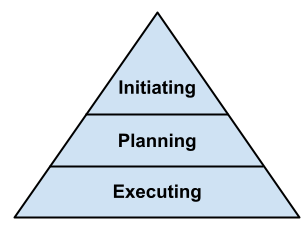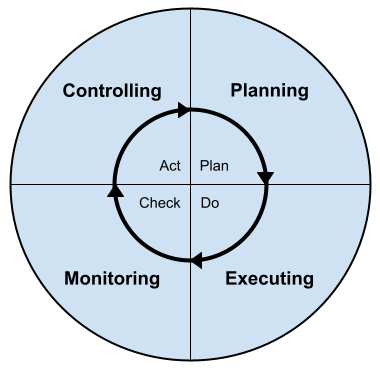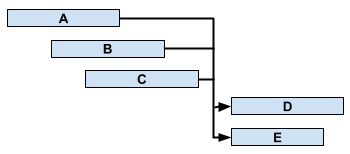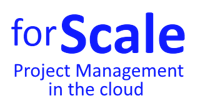Project Management - free Lessons with Quizzes
Get more work done with project management
Project management is useful in a wide range of activities where structured planning, coordination, and execution are needed to achieve specific goals. Starting activities without planning often means a suboptimal result or redoing work, meaning extra time and costs.
 An analogy for this approach is packing your car when you go on vacation.
When items are packed when they arrive at the car, it often happens that a last-minute item, like a football, does not fit anymore.
Unpacking all items in front of the trunk and repacking often solves the problem.
An analogy for this approach is packing your car when you go on vacation.
When items are packed when they arrive at the car, it often happens that a last-minute item, like a football, does not fit anymore.
Unpacking all items in front of the trunk and repacking often solves the problem.
A more coordinated approach where all travelers put their items in front of the car before the packing starts, gives the possibility to plan what items are to be taken and how to fit them more densely.
A lot needs to be managed in a project, basically everything to make it a succes. The way to achieve this has been empirically found and is based on best practices. Some well-known frameworks are PMBOK, PRINCE2 and Scrum. Areas to manage are:
- Deliverables as part of the scope
- Create and track project planning
- Cost tracking
- Quality assurance and control
- Resource allocation
- Clear communication and status reporting
- Stakeholder expectations and concerns
Quizzes
When could Project Management be MOST valuable?
For what activity is Project Management LEAST beneficial?
Examples for improvement
Without proper Project Management a lot can go wrong on different aspects. Some results may look familiar to you. Click to see examples.
Quizzes
What happens when a project has poor resource tracking?
What is neglected when deliverables fail to meet standards?
What causes team burnout and low morale?
Life cycle
A project's life starts with an idea and ends with a result. In order to progress from start to finish, a breakdown in manageable phases is recommended. Each phase has it own goal, meant to decrease uncertainty while work and costs increase.
A project life cycle typically consists of 5 phases, starting at Initiating and ending at Closing. Phases are not necessarily sequential in time. Executing and Monitoring & Controlling take place at the same time. For some projects also Planning can take place at the same time as Executing. In a cyclic type of project, phases are planned more agile, meaning that they can follow external demand; during phase 1 the next phase 2 is planned, etc.

A more static view of the project phases is in a pyramid of abstraction. Initiating is at the abstract and general top and Executing at the concrete and specific bottom. Planning is in the middle and can be determined iteratively by working both top-down and bottom-up.

A dynamic view of the project phases is the Deming circle, where the Plan-Do-Check-Act cycle is presented as a framework for continuous improvement. This shows how the execution is continuously monitored against the planned objectives. If necessary, the objectives or plan are adjusted.

Phases differ per industry, company or even project. Standardization per industry or company helps to compare projects.
Phases
Click the following phases for typical activities.
Milestones
Phases are typically separated by milestones. Here a phase is closed by all stakeholders and the next phase is kicked-off in more detail than it was at the previous milestone.
Quizzes
In what phase do you conduct a feasibility study?
In what phase do you conduct Quality Assurance?
In what phase do you report the status of the project?
Work Breakdown Structure
Project planning requires a top-down breakdown of products and activities to cover the full scope of work. In practice, this breakdown isn't done all at once; components are also identified from the bottom up. Ultimately the scope must be covered from the top down: missed work will lead to massive delay and cost overrun.
In general a Work Breakdown Structure (WBS) forms the basis for planning: a hierarchical decomposition of the work that needs to be done. It has a so-called tree structure with a root node (project scope) and branches to nodes that break down the scope into further details. An end node has no more breakdown nodes and is called a leaf.
In order to understand a node, you need to follow the entire path from root to node. The number of nodes in the path is the level of the node.
WBS example
An easy way to visualize the WBS tree is to indent text. The hierarchical WBS code also shows the breakdown and level of a node. Click on a node to see the entire path.
The WBS codes form a tree:

Products, Activities and Tasks
A project breakdown consists of products (nouns) and activities (verbs). The most structured breakdown is using products for nodes and activities for end nodes, the path forms a task. When you make a breakdown in tasks directly, you use nouns and verbs per node.
The contents of the breakdown can be collected from:
- Requirements documentation for deliverables
- Contracts with obligations
- Previous projects for lessons learned or collected data
- Company policies on projects
- Legal policies that apply for the product or service
- Brainstorm sessions with project team and experts using for instance a mindmap
See video about WBS in Plan project with Tasks and WBS breakdown.
Quizzes
How many end nodes are in the WBS example?
What WBS level has path /software/firmware?
How many end-nodes in the WBS example are activities?
Resources
In order to execute the work in the project's Work Breakdown Structure, resources are required. There are many types of resources, most common is personnel that does the work. Personnel may require other resources like equipment, material, products, external services, etc.
Resources have in common that they cost money and determine the project costs. Depending on the type of resource, the cost per task can be calculated. Work type resources are priced per hour of work.
Resource types
Click on the resource type to see the definition:
See more about resource types in the user guide of ProjectWork.
Capacity
Resources have limited capacity, meaning that their quantity is limited per unit of time. This is most clear for a person resource, who cannot work more than 100%. If a person needs to execute several activities simultaneously, this exceeds his capacity. Also other resources have a maximum capacity, like a skill group of 3 carpenters.
See more about capacity in the user guide of ProjectWork.
See video about Capacity in Plan project work and cost with Resources.
Assignments
The amount of work is estimated per WBS activity and can be divided across the team members. The duration of activity work depends on the number of assigned team members and their availability percentages.
Personnel and equipment are priced per unit of time and the costs depend on the duration of an activity. Material and service are priced per unit and can be assigned to both products and activities, regardless of the time.
See more about resource assignments in the user guide of ProjectWork.
See video about Assignments in Plan project work and cost with Resources.
Quizzes
What contains a Skill group?
Which statement about Assignments is correct?
Planning phase
In the planning phase not only the work itself is planned, but also how the project team is working. In this phase we deal with the work itself, in the Executing phase the collaboration and communication aspects are discussed.
In a schedule the project nodes, like phases, milestones, locations, products and activities are arranged in time. The optimal start and finish dates of activities can be calculated based on their constraints. The start and finish dates of the lower level nodes in a path follow the higher level nodes. This will be explained with a visualization.
Gantt chart
A schedule can be made visible in a so-called Gantt chart, named after Henry Laurence Gantt who developed the chart around 1910. The chart contains the execution duration of the WBS nodes along a horizontal timeline as a bar, and the Work Breakdown along the vertical axis. The dependencies are indicated with arrows between the bars.
Template
You can start a planning by copying a template. The advantage is that you do not need to create the WBS entirely yourself. Comparing projects from the same template is also easier.
Using a template is a good idea when it is a template that you made yourself from an existing project. You can include improvements, found while executing a project, to the template for future similar projects.
Taking a template from a gallery as a quick start has disadvantages. It may not contain all you need and making changes can take a lot of time. Making a WBS is teamwork and a gallery template is likely to distract or mislead.
See video about using a Template in Use Clipboards in a project Template for rollout planning.
Dependencies
Activities in a Work Breakdown Structure may depend on each other in time. As an example, it makes sense to first develop a new function and than test it, rather than the other way around.
Dependencies can be described more general as one or more activities depend on one or more other activities. These dependencies turn the activities into a workflow. With complex dependencies you need to prevent loops in the workflow. As an example, in a Gantt chart dependencies look like this:

Activities D and E can only start when A, B and C are ready. Whether an activity is ready is made visible with a line in the centre of the Gantt bar. When the line has the same length as the bar, it is ready.
Do not confuse the work breakdown with the workflow. Nodes are part of the work breakdown and the workflow, but the breakdown is not part of the flow, see example in Gantt chart:

See more about dependency types in the user guide of ProjectWork.
See video about Dependencies in Plan project with Tasks and WBS breakdown.
Constraints
Solving constraints is the core of Project Management. The main constraints are scope, time and cost. List of constraints:
See video about Overallocation in Perform Resource Leveling to solve project overallocation.
Solutions
Planning a project is in essence finding a schedule that fulfills all constraints. This complex calculation can be fulfilled with powerful Project Management software, like Microsoft Project and ProjectWork.
The Critical Path Method (CPM) solves the Dependencies and Deadlines constraints by first fulfilling the dependencies from project start to project finish and than backwards from finish to start. The nodes that have identical start and finish dates in both directions are on the so-called critical path, meaning that any delay for these nodes results in delay for the project.
Another method that includes the Resources constraint as well, is called Critical Chain Project Management (CCPM). It solves the human resource conflicts and makes explicit when human resources are available in buffers. If human resources are always available, then the Critical Chain is identical to the Critical Path.
When you create a schedule, simultaneous tasks using the same resource can cause the available resource capacity to be exceeded. Resource Leveling solves the human resource constraints by shifting nodes. The result is that no human resource exceeds its available capacity.
See video about Resource leveling in Perform Resource Leveling to solve project overallocation.
Uncertainty
A project is per definition a projection into the future, therefore the amount of work that is required to realize a Work Breakdown Structure is uncertain. The effect of this uncertainty on the project completion date is hard to analyse because of dependencies: nodes that follow each other will statistically counteract their variance, uncertainty in concurrent nodes can cancel out. In general the effect of uncertainty on the project completion date is overestimated because worst-case estimates are simply added.
Instead of analysis, a Monte-Carlo simulation can be used, named after the casino. In each calculation a random selection is taken from the uncertain work according to a probability distribution. Each calculation will result in a project completion date, which accumulate in a probability distribution. From this distribution, confidence levels on project completion dates can be derived. To avoid the time-consuming entry of a probability distribution and lengthy calculations, you can limit the entry to the most uncertain activities.
See more about uncertainty simulation in the user guide of ProjectWork.
See video about Uncertainty in Use Monte Carlo simulation for reliable project completion date.
Quizzes
What is NOT always an advantage of a Gantt chart?
Under which constraint are legal standards listed?
Which statement about uncertainty is correct?
Executing phase
This is where the actual work happens. Having a plan in place, this may sound easier than it is. A planning is an abstraction and an estimate, not reality. Risks that were identified may or may not happen. New insights may require changes. In short, never a dull moment.
Organization
A project needs a temporary organization with roles, responsibilities and reporting lines to do the work. An organizational chart can visualize the roles and structure. Each role needs a clear description of its responsibilities. Accountability prevents unaddressed issues.
Due to the nature of projects, temporal and multi-discipline, the project organization often consists of teams from dedicated departments. Available human resources are assigned to the various project roles. Team leaders report to the project manager.
Information
The flow of information is the bridge between plan and reality in project management. It involves communication, verbally or in writing, and documentation. Information needs to be planned and managed according to the project's goals.
Information needs digital tools for efficiency and effectiveness, like e-mail, chat, video conference for communication and file storage, text editor, spreadsheet software for documentation. More specialized software can be needed like planning software, calendar and maps software.
See video about Google Chat in Chat with team about project schedule.
Meetings
Meetings are meant to compare plan with reality. Examples of meetings are, click for details:
Meetings need an agenda to prepare and to be efficient. The amount of detail in the agenda depends on the purpose.
Meetings have written minutes after the meeting with results and, in regular meetings, action points for follow-up.
See video about Milestones in Publish project Milestones in Google Calendar.
Documentation
Documentation in a project can be divided in categories. Management documents describe the development process for the project team and its organization. Design documents describe the project deliverables. Product documentation is for the paying customer and users of the deliverables after project closing.
Click below for examples of documents by category.
The desired document layout, directory structure, version control and access should be agreed upon as soon as possible, preferably during the initiation phase. Specific projects and industries have their own set of documents.
A project portal is a website where all project documentation is centralized to be accessed by the project team. It can contain additional information like communication, forums, etc.
See video about a Project Portal in Publish schedule in Google Sites project portal.
Quizzes
What facilitates the flow of information?
Which document is a design document?
Quality Assurance
Quality sounds familiar, but what is it? In general fulfilling customer expectations. More specific it is the fulfillment of predefined specifications without defects.
Quality can be split in Quality Assurance (QA) and Quality Control (QC). Quality Assurance aims for preventing defects and Quality Control (QC) for detecting them. QA has a strong footprint in manufacturing, where product variation is to be minimized to reduce rework costs and delays. QA can also be applied to other businesses like projects, mainly to its development processes and methods.
Some QA methods are, click for details:
Change Control
Change Control handles single change requests, unlike Change Management which deals with changes in the strategy of organizations. Change control is divided in following sequential steps. Click for details.
Central part of Change Control is the Change Control Board, where above steps are coordinated and taken.
Procurement
Acquiring goods, services or works from an external supplier is an integral part of many projects. Procurement is divided in following sequential steps. Click for details.
The procurement process is often handed-over after project closing as part of supply chain management.
Quizzes
How are Quality Assurance (QA) and Quality Control (QC) related?
Which statement about Change Control is true.
Which statement about Procurement is true.
Monitoring and Controlling phase
When a project is executed, monitoring is required to see if everything is going according to plan. If differences are noticed, control is required to make adjustments.
Progress tracking
A simple and effective way of monitoring, is tracking the progress of all activities. With a long and complex activity, estimating its progress is difficult and ticking off completion happens late. When you split a long activity into several, more concise activities, delays are noticed sooner.
The progress of a node follows the progress of its higher level nodes. Since end-nodes do not have higher level nodes, their progress can be entered.
See video about Progress in Track project progress in a Gantt chart.
Risk
Uncertain events may require a plan to be revised. Therefore it is required to identify and register risks upfront. Risks which you identify are more likely to be avoided and when they occur the response is already known.
A risk can be quantified by multiplying its likelihood and its impact in time, money or other category. All risks can be calculated in a matrix so you can find the highest rated that require an action plan.
Baseline
When the project planning is adjusted, remembering where you come from is beneficial. This can be achieved by setting a baseline of the planning before you adjust it.
Having a baseline also helps to predict the delay in project completion, based on the Earned Value Method (EVM). This method creates a curve from project start to project finish on the horizontal axis and the accumulated amount of work vertically. Typically an S-shaped curve appears because most of the work is in the middle of the project timeline.
See more about baselines in the user guide of ProjectWork.
See video about Baseline in Use Baseline and Google Sheets for project Reporting.
Reporting
When executing a project schedule, knowing the status of the project is essential to define corrective actions. The status is derived from the actual schedule versus the planned schedule and is typically stated in a report. Depending on what is monitored, this can be a report on progress, cost, risk, etc.
Making reports on a regular basis means it needs to be standardized and preferably automated from well-maintained data. Resulting actions can be re-assigning resources, rescheduling, changing the scope, etc.
See video about Reporting in Use Baseline and Google Sheets for project Reporting.
Quizzes
Which statement about Progress is correct?
Which statement about Risk is NOT correct?
Which statement about Reporting is correct?
Closing phase
The contents of this final phase depends a lot on the type of project and needs to be considered carefully. Deliverables are to be accepted but can be diverse, from physical products, services, events to processes. Partial or full acceptance of deliverables may have happened in previous phases already, to avoid backtracking and unnecessary work afterwards.
This phase is not only about closing but also about transferring deliverables and knowledge to the customer, like operations, support team, sales team, etc. Each deliverable requires its own approach, from delivering a prototype to training. A project's closing also includes the transfer of project team know how to the project teams's organization as best practices or key figures to be used for new projects.
The literal closing includes sending final invoices, settling open accounts, ending running contracts and moving project documents to the organization's archive. The phase ends with a milestone meeting closing all of the above. It ends with thanking the team and celebrating the result.
Which statement about the Closing phase is correct?
Feedback
If you have any questions or feedback about these lessons, please let us know!
Please contact the helpdesk.


